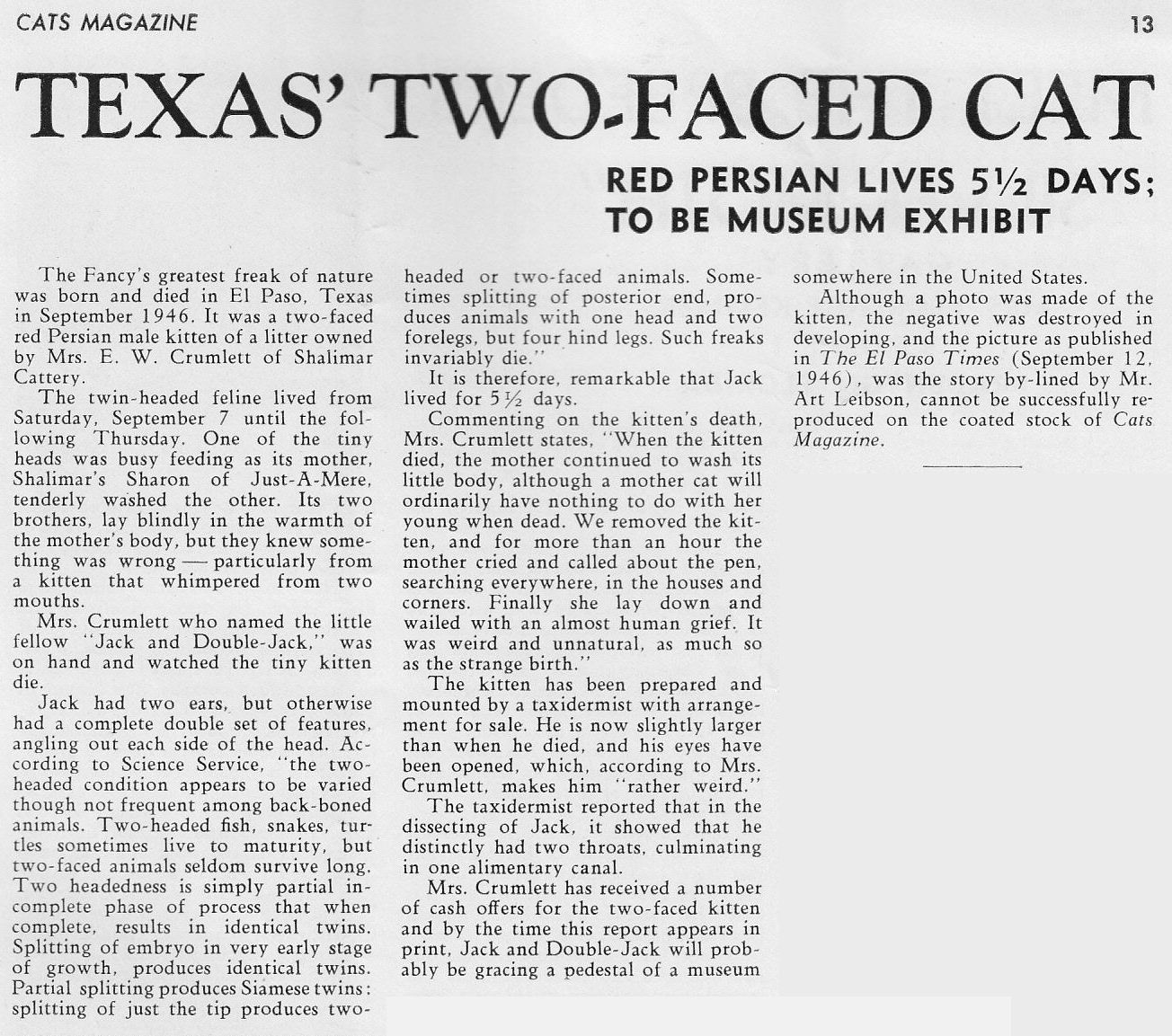
FELINE MEDICAL CURIOSITIES: TWO HEADED / TWO FACED / "JANUS" CATS
Note: Contrary to suggestions on some bulletin boards, the images here are not photoshop. With the exception of those labelled as artist's impressions these are photos of medical conditions. These pages are intended as a medical reference site. Offsite links to images on these pages is not supported - bandwidth costs money!
TWO-HEADED/TWO-FACED KITTENS (FACIAL DUPLICATION)
More striking than extra ears are extra faces; often in the form of two heads fused together. This "Janus" condition may be a form of conjoined twin where the fertilised egg does not completely split in half. More recently, it has been attributed to disrupted embryo growth due to a protein called "sonic hedgehog" which causes excessive widening of the face to such an extent that 2 muzzles are formed. While there are lots of photos of afflicted kittens, I have found no x-ray images or photographs of the skulls of two-faced kittens. It would be very interesting to see how the bones have developed and the duplicate features have formed. Although kittens are born with folded ears and usually (but not always) with the eyes shut, most taxidermy of two-faced kittens shows pricked ears and eyes open for artistic effect.
The sonic hedgehog gene (Shh) controls facial symmetry. There are 3 known hedgehog proteins: sonic hedgehog (shh), desert hedgehog (dhh) and indian hedgehog (ihh). Sonic hedgehog is the most common and best documented of these. The sonic hedgehog protein is made in the notochord of developing embryos. Different levels of the protein cause different types of cells to be formed in the developing embryo. It is involved in separating the single eye field into two bilateral fields, hence a mutation of sonic hedgehog can cause cyclopia. Too much sonic hedgehog causes duplication of structures. It also affects limb development and orientation, neural tube (brain/spinal cord) development and seems to affect the growth of hair, feathers or scales. The many effects of sonic hedgehog demonstrate that when selectively breeding for one trait, there is a danger that the gene controlling the desired trait also controls undesirable traits.
An undated account (possibly between 1900 - 1920) comes from Bromhead, Saskatchewan, Canada. It lived for only a short time and the mother apparently adopted a rabbit after the twin-faced kitten died.
"FREAK KITTEN" (Western Morning News, 4th August 1927): “A CAT BELONGING TO Mr W. Harvey, Lower Quarry, Stentiford Hill, Torquay, has had amongst four kittens one with a single head with two distinct faces, and a third eye in the middle of the forehead. The kitten was born alive, but the mother killed it.”

"Two-Headed Kitten Dies as Mama Cat Washes One Face” - El Paso Herald, Sept 12th, 1946 "
Jack, a two-headed English Persian kitten born Saturday, died early today. He died happily according to his owner, Mrs. E.W. Crumlett of 3915 Pershing drive. One of his little heads was busy feeding while his mother tenderly washed the other. The kittens was normal from the neck to the tail. On his neck were two heads joined together. He had only two ears. Such freaks usually are either dead at birth or die a few moments after birth, veterinarians said. Mrs. Crumlett said Jack’s mother’s strong maternal instinct helped him to live. Ordinarily, when a cat mother gives birth to a deformed or weak kitten she immediately disposes of it, Mrs. Crumlett said. In Jack’s case the mother, Shalimar Sharon of ?ast-a-Mere protected him from his two stronger kin. She gently shoved him into a corner while feeding her two normal kittens. Later she would feed Jack. Early today, Mrs. Crumlett went to Jack’s pen. He was feeding. She touched him, He died at that moment. He had not starved to death because his stomach was round and full. Jack’s body will be mounted so that veterinarians and others interested in freaks may inspect him. Mrs, Crumlett, who has been breeding English Persian cats for five years said the birth was of scientific interest, and a rarity, because Jack's parents were not related. When cats of the same line, or family, are mated, weak animals are born In Jack's case, however, his mother and father are from different families."
And in a follow-up to that article, the El Paso Herald on Sept 16th, 1946 reported "The body of Jack, a two-faced kitten born to English Persian cats owned by Mrs. E. W, Crumlett of 3915 Pershing drive, will be offered to a museum as soon as the body is mounted by a taxidermist. The freak kitten lived five and a half days after birth. His sire and dam were unrelated. Mrs. Crumlett said that excessive in-breeding, or ill-considered mating of parents sometimes results in freaks but that line-breeding and in-breeding correctly accentuates the best characteristics of a line. Because of the fact that Jack's parents were unrelated, his strange , characteristics were of great interest to breeders and veterinarians.”
A two-headed Red Persian kitten was born in El Paso, Texas, in September 1946. The kitten survived for 5 days, apparently suckling with one head while its mother washed the other. It is likely that the second head was not functional. The mother cat was said to have been inconsolable when her special kitten died. There are undated reports of a two-faced kitten called "Xerox".
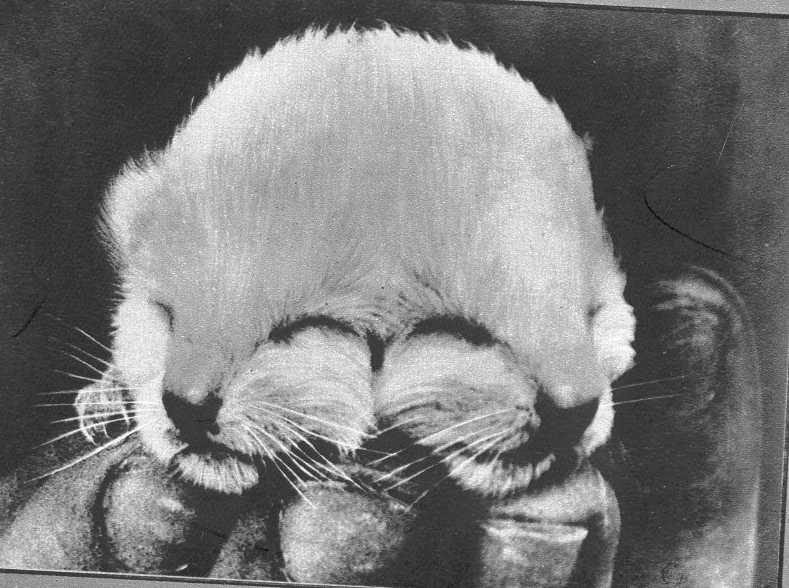
Germaine Vandegoor from Belgium found an account of a 2-headed kitten in the magazine "Weekblad van de stad Antwerpen" dated 29 December 1933. I've included the Dutch and French descriptions as well as the English translation "Little cat with two heads. Photo from 1933 - This cat of Janus (double head) is from California. It has a normal body, and miaows for two". Nederlands: Katje met 2 koppen: Foto uit 1933 - Dit Januskatteken (tweekoppig) is van Californische oorsprong: het heeft een normaal lichaam, vreet en miauwt voor twee. Français: Petit chat à 2 têtes: Photo de 1933 - Ce signe félin de Janus (double tête) est d'origine Californienne : il possède un corps normal, bouffe et miaule pour deux.
A two-headed kitten (undated) dubbed Gemini was born to Dan Lizza's cat in Latrobe, Pennsylvania. Gemini had two faces and two muzzles at right angles to each other. The other 3 kittens in the litter were normal. From all accounts, the owner intended to rear the kitten though there were no further details. In mammals, this sort of deformity almost always results in death because of brain abnormalities. A two-headed, four-eyed kitten was born in July, 1991 in Brighton, Illinois. It lived for just two days. Despite having two mouths, it had only one oesophagus (food-pipe).
|
|
The most complete report is that of a grey kitten called "Image" (below) born in Bensalem, Bucks County, Pennsylvania in June 2000. Image had two sets of eye, two mouths, two tongues and two noses. It was given a good prognosis for survival as long as owner Sandra Pyatt fed it with two eye droppers since it tried unsuccessfully to nurse from the mother with both mouths. Dr. Anil Rastoggi, of the Croydon Animal Hospital, drove over to the Pyatt home to examined Image and found him to be in generally good health. He believed it could survive because the double features posed no health problems, but admitted he had only ever read about this "genetic mutation". Examination showed that it had only one head and two ears. It had two complete faces, but only one mouth connected to an oesophagus and the rest of the kitten seemed normal. Despite one mouth not being connected, both mouths tried to suckle. Reports suggested that Image mewed from both mouths, but with only one oesophagus, one trachea and one set of lungs this would be impossible. Image died four days later and the owner apparently intended to donate Image's body to the Philadelphia Mutter Museum of Medical Oddities.
|
|
There was some doubt in veterinary circles over the authenticity of Image's story since the vet seemed unaware of the lethal brain abnormalities associated with the condition. However, the photos are genuine. In cases of conjoining there is generally a "mirror image" effect and this is sometimes cited as evidence for faked images. In human conjoined twins that have been dissected after death, the internal organs are also mirrored.
In July 1979, a stray cat in Montreal produced a litter of kittens which included a two-headed kitten. The two-headed kitten later died. By coincidence, another two-headed kitten was born in Indianapolis that same month. Named Tom and Jerry by its owner, it later died. Its littermates were normal. Both are more accurately called two-faced kittens. Like Gemini, they had a single skull which split into two muzzles.
On August 22nd 2001, I received an email from Thomas Ross of Livonia, Michigan, USA. Tom's 2 and a half year old cat Carlyle had given birth to 4 kittens on August 19, 2001, her 3rd litter. 3 of the kittens were normal but the 4th (the last born) was a 3.36 oz, 2-faced kitten which Tom and his wife named "Shadow". Shadow had one skull and brain, but 4 eyes, 2 noses, 2 mouths but only 2 ears. When he mewed, both mouths moved but the sound came from one mouth only. In all other respects, the kitten was formed normally. When Tom wrote to me, Shadow was not doing well, having been abandoned by the mother cat. Tom researched the curiosity on the Internet and he and his wife Maralee did what they could for the kitten. However they realised that the kitten's prospects were poor: "Nature was probably taking its course," Ross said, "Maybe the mother realized it wasn't going to live that long." Shadow lived for only 4 days.
|
|
Dr Ben Yamini of Michigan State University's Animal Health Diagnostic Lab (ADHL) said the congenital malformation likely occurred early in the embryonic process. Without examining Shadow he could only guess at a cause, but some viruses or exposure to certain toxic substances (known as teratogens, meaning "monster causing") can cause birth abnormalities. In 25 years, Dr Yamini had encountered other unusual cases such as two-headed calves, but had never seen this particular defect in a cat. Ross contacted a Philadelphia Physicians College staff member, who may be interested in examining Shadow's remains which were being kept in the family's freezer. Ross wanted a hospital to use Shadow's remains for research. For the record, Shadow was not the first unusual cat in the Ross household - they once took in a kitten which had an extra paw on one leg. (Information and photographs of Shadow courtesy of Tom Ross.)
These photos and accompanying information have kindly been provided by Jean Jahoda, a breeder of Persians. In this case, the angle between the two muzzles is relatively small and there is a single central eye; there appears to be a hare lip (and possibly cleft palate) on each of the two muzzles. Jean described the sound of the two muzzles crying at birth as especially bizarre. (Description & photos copyright Jean Jahoda)
|
|
Jean writes "On July 28th, 2003 the following kitten was born alive. It died within minutes of its birth. This kitten shared a placenta with another perfectly normal kitten. By shared we mean that each kitten's umbilical cord was attached to the same placenta. The normal kitten is a male. This kitten was a female. As can be seen, the kitten has two ears, two noses, two mouths and three eyes. The center eye was open at birth. The other two eyes, as normal, were closed. The kitten was alive and crying. Immediately after the umbilical cord was removed it died. Look at the mouths and you will see full teeth on the bottom of each mouth. Kittens don't normally get their teeth in until 3-4 weeks of age."
On 8th March 2005, a two-faced kitten was born in Lake City, Florida, USA to a cat owned by Teresa Morrison. "Deuce" had two muzzles (two mouths and two noses) and four eyes. Unlike many of the two-faced kittens reported here, Deuce was able to nurse from its mother using one mouth. The other mouth did not appear to function. The veterinarian had not seen any similar cases first hand, but believed that if the kitten did not have brain abnormalities and managed to survive the first 48 hours, the prognosis was said be good. Deuce died two days after his birth. His owners were apparently forced to put Deuce to sleep when the kitten developed pneumonia and was not strong enough to survive. The pneumonia may have been caused by inhalation of milk into the lungs as one muzzle fed while the other breathed. To date, no kittens with this abnormality have survived beyond a few days and the only two-faced mammal known to have survived into adulthood was Ditto the pig.
On Sunday 12th June 2005, a two-faced kitten was born in Roseberg, Oregon, USA to a cat owned by Glide resident Lee Bluetear who had been breeding 4 lb miniature cats. Gemini was born to a miniature mother and normal size father. "Gemini" had two mouths, two tongues, two noses and four eyes, but a single windpipe and oesophagus. Bluetear could not be sure if the kitten would survive, but believed that if she did she would be perfectly normal apart from having 2 faces. Veterinarian Alan Ross examined the kitten when it was 2 days old and gave it a 10 percent chance of survival. He and his 2 colleagues had never seen a two-faced kitten before. Gemini was said to be getting stronger and suckling well, but if she did survive she would need surgery to remove extra tissue between her two mouths. Not unexpectedly, Gemini died aged 4 days, having become very lethargic on the Thursday and not wanting to eat. The exact cause of death was not known. Bluetear was considering giving Gemini's body for academic or scientific study.
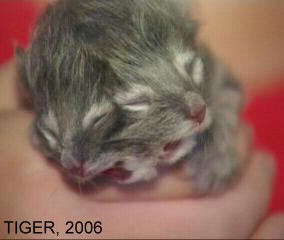
A two-faced tabby kitten was born in Grove City, Ohio, USA on 12th July, 2006 to a cat owned by the Roberts family. Called Tiger, the other 2 kittens in the litter are normal. Though born in the morning, the kitten did not start nursing until the afternoon and is unlikely to survive for long. It has two muzzles, 2 mouths that mew in unison and 4 eyes. On Saturday July 16th, the kitten apparently vanished from its Grove City home. It had been bottle-fed, due to being unable to suckle from the mother, and had last been seen just after Friday midnight. When checked at 4 a.m. it was not in the bed with the mother (a newborn kitten should have been fed every 2 hours, 4 hours between feeds is too long). There was no sign of the kitten and the family believed it was stolen as one of their doors was unlocked, however their dog did not raise the alarm. The most likely explanation is that the malformed kitten was dying and the mother ate it - this is a normal, natural thing for a mother cat to do.
A similar kitten was born at Ste-Genevieve-de-Batiscan, near Trois-Rivieres, Quebec, Canada on 14th July, 2006. It had a single head with 4 eyes, 2 noses and 2 mouths but one head. Dubbed "Two Face," it appeared to be healthy, but died 3 days later. The mother was owned by France Trudel and the kitten's deformity was noticed by her daughter Valerie Bastarache. Veterinarian Isabelle said the malformation was probably due to a problem with cellular division in the foetal stage. Although she hadn't examined the kitten, she said that internal organs, including the brain were probably also malformed.
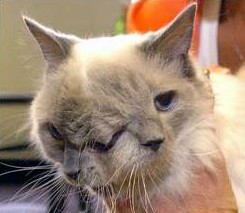
A 2-faced cat in Millbury was 6 years old in 2006. Named "Frank and Louie" (so that each face had a name), the owner's details were withheld due to the excessive publicity surrounding recent 2-faced kittens. This cat is the exception. He has 2 mouths, 2 noses and 2 functioning eyes plus a 3rd central eye that doesn't function. Only the mouth on the cat’s right side (Frank’s side) is connected to the oesophagus (food pipe), so that side does the eating. From either side the cat appears normal, but head on the 2 faces are apparent. He has a sweet personality and was adopted by the owner from a vet clinic at 1 day old when taken for euthanasia. He came from a breeder who did not want her line associated with congenital defects. His adopter tube fed the kitten every 2 hours - running a tube down the throat and straight into the stomach so there was no danger of choking. Although most such kittens die within a few days due to internal problems, Frank and Louie survived. He is healthy and plays with other cats and the owner's dog and likes walking on a leash. All the teeth in the non-eating mouth have had to be removed. Because the eyes are placed almost on the sides of the head rather than at the front, he has limited binocular forward vision, but has learnt to compensate for this.
In September 2011, Frank and Louie gained a place in the Guinness Book of Records as the longest surviving cat with the "janus" condition. In November 2015, he became ill and was put to sleep after being diagnosed with cancer. The media often called him Frankenlouie.
Another surviving 2-faced kitten was reported in November 2007. Lil'Bit is a 7 month kitten from Arizona and was one of a litter of 5 kittens. He could not suckle and was hand-reared. Originally, the 2 eyes in the centre appeared separate, but as Lil Bit grew they apparently converged into a single eye sockets. His noses and mouths are separate; it is not reported if both muzzles are capable of feeding and breathing. It was suggested Lil'Bit had 2 fused brains, or at least separate control of each faces, because the faces sleep, wake and blink independently of each other. One face appears to be less well-developed than the other. When he caught a cold, only one nose ran (which suggests the non-runny nose and mouth aren't fully functional otherwise the cold virus would have spread via a shared trachea and oesophagous).
|
|
A two-faced kitten was born in Amarillo in February 2008 to a 3-year old Persian-mix female owned by Renee Cook. Nicknamed "Double Trouble" by the media, it had 2 mouths, 2 noses and 4 eyes. The other 6 kittens in the litter were normal. The 2-faced kitten was rejected by the mother and found slightly apart from its littermates. When found, it was cold and sluggish, but once warmed up it had a strong heartbeat and began to move. Cook went to the Northwest Texas Hospital and obtained some formula from their paediatric ICU and a syringe (human formula is far too weak for kittens - she should have procured kitten milk replacement). The kitten was unable to latch on or suckle, but could swallow and be syringe fed. According to vet Dr David Hodges, its chances were slim and depended on how the lungs, two tracheas, oesophagus and mouths were connected. Its lower jaws appeared to be under-developed so if it survived it would be unable to chew. (News reports erroneously called the mother a "Persian and Calico mix" - calico is a colour, not a breed).
|
|
Another two-faced kitten was born at the start of August 2008 to a shop cat at Woodville Auto Finance in Northwood (outside Toledo), Wood County, ohio. The grey-tabby-and-white kitten had four eyes and two noses, but only one functioning mouth (on the kitten's right side). On the kitten's left side, the face was less well developed with a hole beneath the nose. The mother cat had been hanging around the shop for several years. She appeared not to mind the abnormality, nursing and caring for the kitten until its death on 6th August. Video footage shows the kitten to be alert and active indicating it was able to suckle. It may have died due to inhaling milk while suckling. In November 2008, a 2-faced grey-and-white male kitten with a cleft palate in one face was born in Perth, Western Australia. Both mouths can miaow in unison (both are connected to the trachea). The mother had been taken to the Swan Veterinary Clinic in Perth due to complications during the birth. The litter of three kittens were delivered by vets George Huber and Louisa Burgess. The 2 littermates had no deformities. The clinic has seen cats with 2 tails and with extra legs, but had not previously seen a 2 faced kitten. Initially it was doing well, suckling with one mouth only due to the cleft palate in the other, but it died at 3 days old; asphyxiating after getting fluid in his lungs. There were concerns about neurological problems due to unusual behaviour such as excessive head shaking. The owner had considered naming it Mr Men or Quasi Modo if it survived.
A two-faced kitten was born in Charleston, West Virginia, USA in June 2010. The mother cat refused to suckle it and the unidentified owner took the deformed kitten to North Gateway Animal Hospital where it was examined by vet Dr Erica Drake. The kitten has 2 muzzles and 4 eyes and its mouths act independently of each other which could mean 2 oesophaguses leading to its single stomach (this could be bad news - if one muzzle breathes while the other is suckling it could lead to inhalation pneumonia caused by milk entering the lungs). No X-rays have been taken so far to see exactly what is going on inside which means though the kitten seemed otherwise healthy, it wasn't possible to give an accurate prognosis.
|
|
Nathan Roberts provided this photo of a diprosopus kitten, called Prof Harvey Whiskers. This kitten was born in West Virginia, and lived for four days before finally passing away. The birth was the product of the mother cat, and one of her sons from a previous litter, though it is unclear if the inbreeding contributed to the cranial defect. Nathan collects animal specimens with severe teratological defects and is interested in purchasing and preserving other specimens.
|
|
Another two-faced kitten (now increasingly being termed Janus cats by the media) was reported in February 2012, but survived only a short time. It was born in Port Charlotte, Fla, USA and named Harvey Dent after the "Two-Face" character in the Batman series. The kitten had four eyes, two noses and two mouths. All of the duplicated external features appeared to function and the mouths worked simultaneously, both when eating and mewing (it is not known if both had a functioning oesophagus/trachea). Although the kitten's owners Nash Hand and his wife Amanda Forsythe hoped it would survive, some critics referred to it as an abomination and called for it to be put down. Harvey Dent survived only two days.
A 2-faced kitten was born in Missouri on May 9th 2012, but did not survive long after birth (Jean/Jstieh).
|
|
A two-faced (janus) kitten was born in Amity, Yamhill County, Oregon on Tuesday 12th June 2013. "Duecy" was examined by a vet and appeared to be in good health despite the deformity, however she was rejected by the mother cat and owner Stephanie Durkee attempted to hand-rear her. The kitten died two days later from complications associated with its deformity.
Such mutations are not actually becoming more common. They remain rare, but are better reported due to the speed and inexpensiveness of the internet, email and digital photography. Owners now have a ready market for photos and videos of such mutations. In the past, the animals or their remains were sold to exhibitors of curiosities and were seen by relatively few people. In modern times, news and images of mutant animals can spread worldwide in less than 24 hours.
Although "two-faced" or "two-headed" kittens survive only a few days, a two-snouted pig called "Ditto" (2 snouts, 2 mouths, 3 eyes) survived to maturity. Several genetic disorders cause extremely wide-set eyes (hypertelorism). One such disorder is due to mutations in a gene that normally limits the activity of a protein called sonic hedgehog. A lack of sonic hedgehog causes cleft lip. Hypertelorism syndrome causes very broad noses, noses with two tips, or even two noses. Once the face of the embryo widens beyond a certain point, whole structures (e.g. nose, mouth) are duplicated. Ditto, a Duroc pig born in Iowa, had two snouts, two tongues, two oesophagi and three eyes. It may have started out as two twin embryos that fused, but because the duplication was confined to the face and forebrain it is most likely that it grew from a single embryo with a very wide head. Ditto died in 1998 and his head is preserved in a jar at the University of California, San Francisco. Ditto died of pneumonia, apparently caused by inhaling food into one snout while the other snout was eating. Two-faced individuals caused by sonic hedgehog aside, statistically, conjoined twins are more often female than male. This is because a female embryo is more likely to split into twins than a male embryo. Sometimes the split is incomplete, leading to conjoined individuals.
|
|
|
FACIAL DUPLICATION X-RAY IMAGES
The images from veterinary nurse Erin Peters (Animal Emergency of McHenry County Crystal Lake, IL,USA) show the skull structure of a two-faced kitten. Erin dealt with a semi-feral cat that was trapped due to having a stuck kitten after delivering 2 stillborn kittens. The 3rd kitten had facial duplication and was photographed and radiographed by Erin to help other veterinary staff visiting this page.
|
|
|
|
FACIAL DUPLICATION SCIENTIFIC STUDY
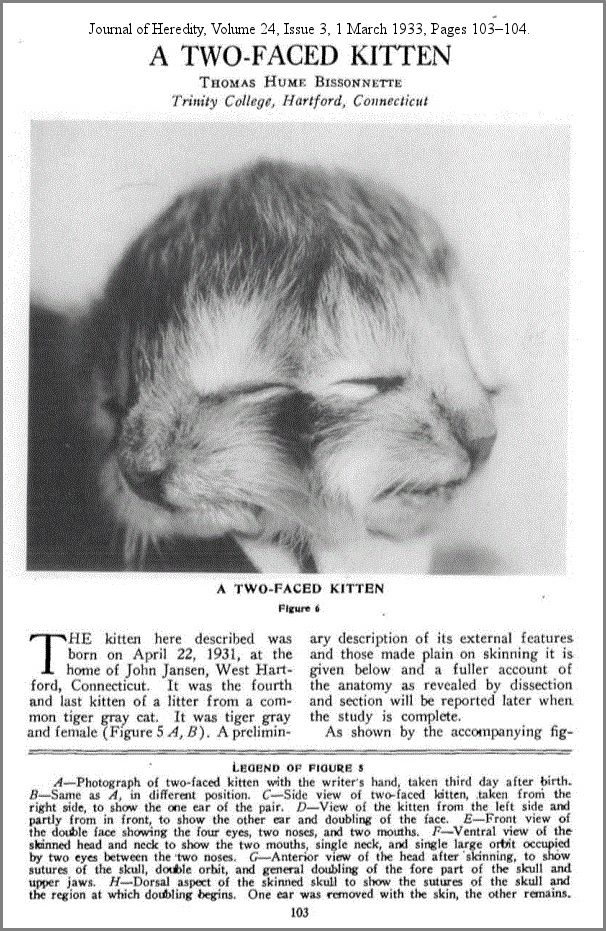
The internal anatomy of a two-faced kitten was described in “Diprosopia in a Cat” by J. Camon , J. Ruberte and G. Ordonez (J. Vet. Med. A 37, 278-284 (1990)). This is a layman’s summary of their findings. The paper is available online and deals with the face and brain structure in depth.
The diprosopic kitten examined by the authors was the fourth and last kitten of an otherwise normal litter from a mixed-breed female. Its siblings were all normal. It survived for 1.5 days, dying because it was unable to suckle. It had two snouts, three eyes and two ears were present. It had a single, non-movable lower jaw because the skin of both upper lips and the single lower lip was partly fused. The lower jaw was not completely duplicated and it was positioned between the two upper jaws which meant the mouths could not close. The two tongues were joined together at the base (the opening of the single throat). Behind the skin there was a third, central, eye in a central eye-socket. The eye was internally normal, but the tear duct and the third eyelid were at opposite sides of the eye instead of the same side. This is described as triopthalmia (three-eyes). From the neck to the tail it was a normal female kitten.
The brain was partially duplicated. External examination of the brain revealed the mid-brain and hind-brain to be normal, but the forebrain was abnormal. Instead of a single pair of cerebral hemispheres there were two pairs of incomplete cerebral hemispheres, the right cerebrum being slightly larger than the left one. The fissure between the two hemispheres was therefore Y-shaped and some structures were asymmetrically duplicated. The authors described the brain structure in detail.
Diprosopia is considered to be a defective anterior (front of body) twinning with partial or complete craniofacial duplications. There is no definitive data on frequency of this malformation in cats, but it is a rare condition (SAPERSTEIN et al., 1976). When considered in the context of conjoined kittens, the two-faced condition is a common form of conjoining common (PIA, 1971). GEOFFROY-SAINT-HILAIRE corded twelve cases. Other case reports have been published by LESBRE and GUINARD (1891), LESBRE and FORGEOT (1906), SCHWALBE (1907), KEIL (1912), DE LIMA (1918), BISSONNETTE (1933), MOITAS (1939), ELLINGER et al. (1950), ANTIN (1956), GAUNT (1957), MARQUES (1962, 1965), and GERISCH and WILKENS (1976). Anatomical studies in these articles are scarce, and only descriptions of external or particular features have occasionally been made. It is generally accepted that diprosopia begins during early gastrulation (where the ball of embryonic cells forms a tube) resulting from partial anterior splitting or duplication of the “primitive streak” that form the head (DUHAMEL, 1966; DOLLANDER and FENART 1979). Severity ranges from slight duplication of foremost craniofacial structures to almost complete dicephalia (two complete heads).
The authors referenced the following papers relevant to this condition in cats.
MORE ANOMALIES
If you have come to this page directly from a search engine, please check out
FELINE MEDICAL CURIOSITIES for the full index of topics includingBOOKS ABOUT ANOMALIES
If you are interested in medical curiosities, books worth reading are "Mutants: on the Form, Varieties and Errors of the Human Body" by Armand Marie Leroi and "Anomalies and Curiosities of Medicine Vols 1 and 2" by George M. Gould & Walter L. Pyle. The Gould & Pyle books were published in 1896 and are in the public domain. You can download text-only versions of Gould & Pyle from several websites so don't waste money on text-only versions of the book; but if you want the versions with photos, consider the Kessinger editions. The Leroi book explains why and how some deformities and anomalies happen - the mechanism is the same in cats as it is in humans.
You are visitor number